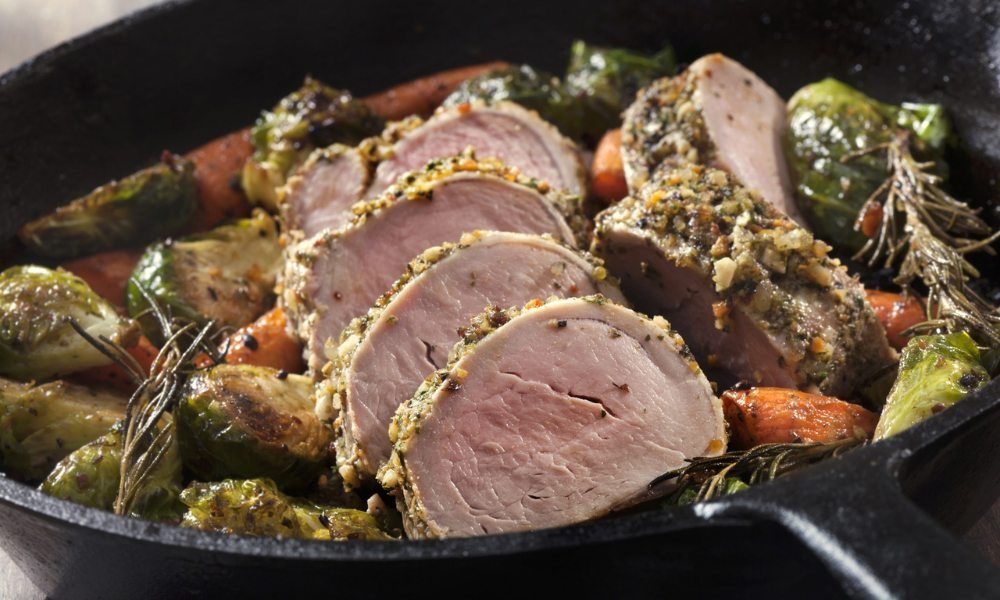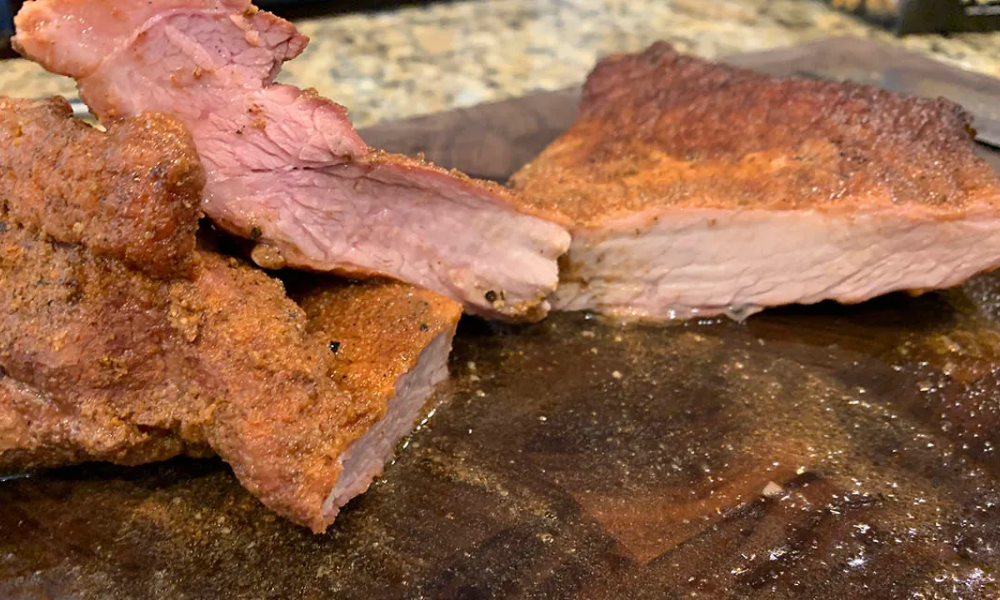Is it safe to eat pink pork? When you cut the pork and discover it is still pink, you’ll ask your parents or friends this question. What are you going to do if they don’t know the answer? You don’t need to be concerned because this post will blow your mind with a single click!
Aside from answering your question, this article also explains why your pork is still pink, the dangers of eating undercooked pork, and how to check the doneness of the pork. Everything you need is right here, so sit back and discover!
How can you Eat Pink Pork?
Read on if you’ve ever questioned how to eat pink pork.
It is generally not advised to consume pink-colored pork because it may not have reached a safe internal temperature to kill any harmful bacteria that may be present. To be safe to eat, pork should be cooked to an internal temperature of 145°F (63°C), with a three-minute rest time after cooking to allow the temperature to rise to at least 160°F (71°C).
Pink-colored pork may not have reached this safe internal temperature and may be undercooked, posing a risk of food poisoning. It is critical to use a meat thermometer to accurately check the internal temperature of the pork before serving to ensure that it has reached the recommended temperature.
If you are unsure whether your pork is fully cooked, err on caution and cook it for a little longer to ensure it is safe to eat. To reduce the risk of foodborne illness, handling and storing pork safely is also critical.
You are these examples of washing your hands before and after handling raw pork, keeping raw and cooked pork separate, and storing raw pork in the refrigerator until ready to cook.
Reference: Evaluation of Safe Food-Handling Instructions on Raw Meat and Poultry Products
Is There Any Health Danger?
If cooked properly, pink pork is safe to consume. The color may change depending on the type of meat and the cooking technique. Use a thermometer to check that the pork is cooked through and to cook it to a safe temperature.
A minimum temperature of 160 degrees Fahrenheit is advised for cooking solid pork slices, according to the United States Department of Agriculture (USDA). Although this temperature is rather low, it effectively kills bacteria and prevents trichinosis, which is brought about by consuming undercooked pork.
Here is a brief explanation of pink pork if you are concerned about eating it and why it isn’t necessarily bad.
Many factors, such as undercooked meat, high heat, and chemical reactions, might produce pink pork. Pork that isn’t cooked to a safe temperature should never be consumed.
Before serving, ground pork should achieve a minimum temperature of 165 degrees, according to the FDA. This is done so that the ground meat will kill any bacteria that might have been present during processing.
Can Numerous Pathogens be Found in Raw or Undercooked Pork?
Nowadays, pigs are fed differently, and farming methods have evolved. This is one of the factors lowering the number of foodborne diseases connected to pork.
You should use caution if you consume raw pork. Hazardous germs and parasites may be present in this meat. Cross-contamination with other foods can also taint it.
Pork should be cooked to a temperature of 160 degrees Fahrenheit, according to the US Department of Agriculture (USDA). Check the temperature of the meat with a food thermometer if you are cooking it yourself.
It’s critical to remember that the type of meat, the cooking technique, and other elements may affect the color of the pig. Pork belly, for example, has more myoglobin than loin or ribs because it is less lean. But even the smallest pink streaks in the meat can signify that it wasn’t cooked through.
Make sure your raw pork is stored in disposable plastic bags to reduce the chance of cross-contamination. Additionally, it’s a good idea to cook the meat until it is steaming before eating it.
May Overcooked Food Turn Leathery and Dry?
Stringy and dry food might result from overcooking pink pork. Use a meat thermometer to test whether your pork is cooked through. It is still a food that is safe to consume.
Cooking pork at the proper temperature is the most crucial step in the process. Getting your meat to that juicy, tender condition should be simple if you follow the right steps.
There are various methods for doing this. Before cooking, you might choose to marinate your pork. Or you could rub some spice on it. You can make your pork taste good in all of these ways. But remember that for the best flavor, you should cook your pork to the appropriate temperature.
Additionally, think about how good your pork is. Your pork should ideally be juicy and moist. t would be best to avoid consuming any rough meat.
The pH of your cooked pork might impact the color, among other things. Your pork will release pink juices if it is acidic. The muscle quality of the animal will also have an impact on the color of your pork.
What are the Benefits of Eating Pink or Raw Pork?
Eating raw or pink pork can be rewarding, depending on several variables. The color of the meat, how it was prepared, and the type of pork cut are some crucial elements to consider.
The amount of time it is cooked and the chemical reaction between amino acids are two of the more frequent causes of pink pork. Pork slices vary in their suitability for cooking and for serving raw.
Pork must be cooked to the right temperature to kill microorganisms. At least 145 degrees Fahrenheit should be present inside. The ideal instrument for taking this reading is a pork thermometer.
There are a few exceptions to this rule, though. Before cooking, several varieties of pig are cured. Curing increases the meat’s shelf life and aids in flavor preservation.
On the other hand, when being processed and packaged, some varieties of ground pork may pick up bacteria. The consumption of ground pork is still safe despite these issues. Maintain a 160-degree internal temperature when cooking ground pork.
How do you Tell When a Pork Roast is Done?
Use a meat thermometer to determine the exact cooking temperature of the pork. Although you can pierce the meat to see if the fluids run clear or probe it with a skewer, these techniques cannot guarantee that the meat has achieved a safe temperature.
Slice into the meat after it has rested for at least 5 minutes; it should be pale white with a tinge of pink. Your pork is “medium rare” at 145°F; thus, that color doesn’t mean anything sinister. Don’t be shocked if you see some pink in your pork chops; you would expect to see some in a medium-rare steak.
You can keep cooking it until it reaches 155°F if the pink tint frightens you. If you cook it any further than this, a nice sauce should be served on the side to smother the dry parts. Although less juicy, it will still taste well.
Why is Pink Pork Possible?
Pork will become tan or white when it is cooked. The pork may occasionally still be pink or a little bit pink even after reaching the appropriate temperature. What causes this to occur?
One of the causes of color maintenance is nitrates. They are substances that are added to food as additives to improve color. Because the reaction between nitrates and protein stops the release of oxygen, a pink color is left behind.
Long-term protein-amino acid interactions might cause the flesh to turn grey or brown. The meat cuts could turn pink as a result of this reaction, though, due to chemical variations. In addition, the duration of cooking may be a factor in this problem.
Do you realize that the color of your pork also depends on the cuts you use? Meat cuts with more fat, such as pork belly, have a better chance of remaining pink inside because they contain more myoglobin.
Additionally, the pink color of the pork may be caused by the PH level, cooking technique, or seasonings. For instance, some proteins denature more quickly than usual when meat is seared or grilled at a high temperature, resulting in pink pork.
Pink inside meat does not necessarily indicate rare pork.
Conclusion
To minimize the risk of foodborne illness, handling and storing pork safely is critical. You wash your hands before and after handling raw pork, keep raw and cooked pork separate, and store raw pork in the refrigerator until ready to cook.
It’s simple to determine whether pink pork is safe. When cooking, keep the temperature at 145°F. If the pinkness bothers you, raise the temperature to 155°F to ensure your pork is safe to eat.

